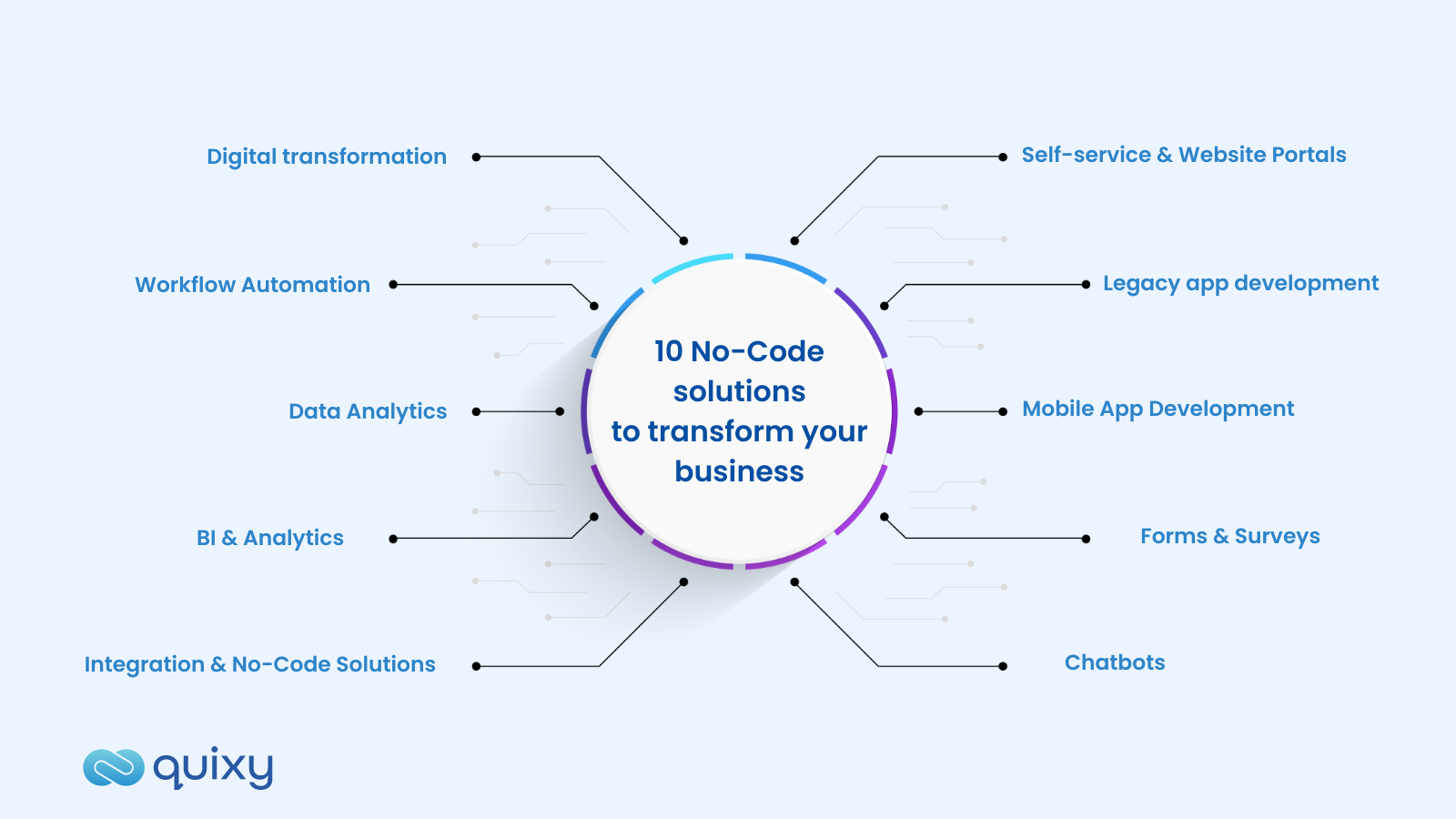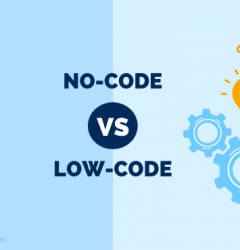
In today’s fast-paced business environment, organizations constantly look for ways to improve efficiency and streamline operations. One solution to this challenge is using no-code low-code platforms, which allow businesses to build custom applications without writing complex code. With the right no-code low-code solution, businesses can automate manual processes, improve customer experience, and integrate with new technologies, all while reducing the workload of IT teams.
This blog will introduce 10 no-code solutions your business can build to empower your operations. These solutions can help transform your business and drive growth and success, from automating manual processes to streamlining internal systems. Whether you’re a small business looking to improve efficiency or a large enterprise seeking to modernize your legacy systems, these no-code solutions can help you achieve your goals.
So, if you’re ready to transform your business and unlock your full potential, keep reading to discover the power of no-code solutions.
How do different industries leverage No-Code automation solutions?
No-code technology allows businesses to create custom software applications quickly and easily without extensive programming knowledge. Different industries leverage no-code in various ways to streamline operations and improve efficiency.
No-code is used in the banking and financial services industry to create custom applications for risk management, fraud detection, and compliance. A study by Forrester Research predicts that no-code will be used in 70% of the new banking and financial services industry applications by 2023.
The manufacturing industry is also leveraging No-code to create custom applications for inventory management, supply chain management, and predictive maintenance.
No-code Global Market Report estimated the global no-code market to be worth $15.2 billion by 2027, growing at a CAGR of 38.8% from 2020 to 2027.
No-code creates custom supply chain management, inventory management, and customer management applications in the retail industry.
Overall, it can be seen that different industries are leveraging No-code application areas in various ways to improve their operational efficiency and stay competitive in today’s digital age.
Here are 10 Solutions you can build with No-Code Technology
No-Code technology is the key to unlocking the full potential of your business and streamlining your operations. With no-code solutions, businesses can create custom tools, applications, and software with ease and without the need for technical expertise. These user-friendly solutions offer a visual interface and pre-built templates, empowering non-technical users to customise their solutions to their specific needs. By embracing no-code technology, businesses can experience the freedom of effortless innovation, saving valuable time, resources, and costs while gaining access to the powerful tools and features necessary for growth and success.

1. Digital transformation with No-Code solutions
Digital transformation refers to integrating digital technology into all business areas, resulting in fundamental changes to how the business operates & delivers value to customers. No-code platforms play a significant role in digital transformation by providing a visual interface for building and customizing applications, allowing non-technical users to create and update digital solutions without writing any code.
Some common use cases for no-code in digital transformation include:
- Automating manual processes: No-code platforms can automate manual processes, reducing employees’ workload and improving efficiency.
- Improving customer experience: No-code platforms can be used to create digital solutions that improve the customer experience, such as mobile apps, customer portals, and chatbots.
- Streamlining internal processes: No-code platforms can be used to streamline internal processes, such as HR, finance, CRM in marketing, and IT, improving efficiency and reducing the workload of support teams.
- Integrating with new technologies: No-code platforms can be used to integrate legacy systems with new technologies, such as cloud computing, artificial intelligence, and the Internet of Things.
By leveraging no-code platforms, organizations can rapidly and cost-effectively transform their digital capabilities, improving efficiency, competitiveness, and customer satisfaction.
2. Workflow Automation
No-Code is crucial to the future vision for workflow automation. These technologies empower non-technical users to easily create, configure, and automate business processes without extensive programming knowledge.
With the advancement of these technologies, it is expected that businesses will be able to automate even more complex tasks with more advanced features and capabilities. This will improve efficiency and productivity and enable organizations to keep pace with the changing market conditions and customer needs. Additionally, the increasing adoption of artificial intelligence and machine learning will further enhance the capabilities of No-code platforms, making them even more powerful tools for businesses to use.
Companies can streamline their operations, reduce costs, and improve the customer experience using these technologies. Businesses can also use no code to build custom applications that empower their operations, such as automating repetitive tasks or creating personalized dashboards and reports to monitor their performance. No code is expected to be vital component of process automation in the future and will play a crucial role in helping businesses achieve their goals.

3. Data Analytics
Data analytics is crucial for businesses looking to make data-driven decisions. It allows them to extract meaningful insights from large data sets and make informed decisions based on that information. No-code solutions can help businesses create customized data analytics system that fits their specific needs, such as data visualization, data mining, and machine learning. With a no-code platform, businesses can easily create custom applications that automate their data analytics processes.
This can include everything from visualizing and mining data to machine learning and prediction. No-code solutions also allow businesses to integrate their data analytics systems with other business systems, such as CRM, ERP, and e-commerce platforms, providing real-time visibility into all aspects of their operations.
No-code solutions can help businesses to quickly respond to changes in their data analytics strategies by allowing them to quickly adapt their processes and systems to meet the needs of their business. No-code solutions can provide businesses with the tools to streamline their data analytics operations, improve efficiency, and reduce costs.
Also Read: Sneak-peek into Top 10 Predictions for No-Code Low-Code Adoption by Businesses
4. No-Code Solutions with BI & Analytics
Organizations can quickly and easily create custom dashboards, reports, and data visualizations using no-code platforms and make sense of their data in real-time. This can help organizations to gain valuable insights into their operations, identify areas for improvement, and make data-driven decisions.
Additionally, no-code BI and analytics solutions can be easily scaled to meet the organization’s changing needs. They can be integrated with other systems and tools to view the organization’s data comprehensively.
No-code development is becoming increasingly popular for organizations to create BI and analytics solutions, providing a fast and efficient way to turn data into actionable insights and make data-driven decisions.
5. Integration & No-Code Solutions
Integration in no-code apps refers to connecting different software tools and services seamlessly. This allows users to automate workflows, share data and information, and streamline processes without writing code. No-code integration is typically achieved through a visual interface, such as drag-and-drop, that enables users to connect different tools and services with minimal technical knowledge. Examples of no-code integrations include:
- Connecting a form builder to a database.
- Integrating a payment gateway with an e-commerce platform.
- Connecting a project management tool with a team communication app.
A use case for no-code integration could be for a small business owner who wants to streamline their sales process. The business owner uses a no-code platform to create a simple online form for customers to place orders. The form is connected to a payment gateway, allowing customers to make payments online securely. The form data is then automatically sent to the business owner’s customer relationship management (CRM) system, allowing them to track and manage customer orders and information.
The business owner can also use the integration to trigger automated email confirmations to customers and update their inventory management system to reflect the new order. These integrations can be set up and managed without coding, making it easy and accessible for the business owner to streamline their sales process.
Also Read: How No-Code can transform the BFSI Industry?
6. No-Code Solutions for Self-service & Website Portals
Self-service portals using no-code apps refer to web-based platforms that allow users to access information and perform certain tasks without needing assistance from IT or other support teams. These portals are typically created using no-code platforms, which allow non-technical users to build and customize their web portals using drag-and-drop tools, pre-built templates, and other visual interfaces. Some common use cases for self-service portals include:
- Employee onboarding: allowing new hires to complete paperwork, view company information, and access benefits information.
- Customer support: providing customers with a centralized location to access information, submit support requests, and track their status.
- IT service management: allowing employees to request IT support, track the status of their requests, and access information about IT services.
- HR portal: providing employees with access to HR information, such as benefits, policies, and forms.
- Community portals: allowing community or organization members to access information, participate in discussions, and collaborate on projects.
These portals can improve efficiency and reduce the workload of support teams by allowing users to access information and perform tasks independently without needing assistance.
7. No-Code Solutions for Legacy app development
Legacy app development with no-code refers to creating or updating existing legacy applications using no-code platforms. Legacy applications are older software programs developed using outdated technologies and are often difficult to maintain or update. No-code platforms provide a visual interface for building and customizing applications, allowing non-technical users to create and update legacy apps without writing code.
Some common use cases for legacy app development with no-code include:
- Updating outdated user interfaces: No-code platforms can create modern, user-friendly interfaces for legacy apps, making them easier to use and improving the user experience.
- Integrating with new systems: No-code platforms can integrate legacy apps with new systems and technologies, allowing them to work together seamlessly.
- Automating manual processes: No-code platforms can automate manual processes within legacy apps, reducing users’ workload and improving efficiency.
- Adding new features: No-code platforms can add new features to legacy apps, such as mobile compatibility, reporting, and data analytics.
Legacy app development with no-code can help organizations modernize their legacy systems, improve efficiency, and reduce the workload of IT teams, all without having to write complex code.
8. No-Code Solutions for Mobile App Development
Mobile apps have become a crucial aspect of business operations in today’s digital age, allowing businesses to engage with customers, sell products, and coordinate logistics. No-code solutions can help businesses create custom mobile apps that fit their specific needs, such as customer engagement, sales, and logistics coordination.
With a no-code platform, businesses can easily create custom mobile apps that automate their business processes. This includes managing inventory, tracking orders, coordinating logistics, and engaging with customers. No-code solutions also allow businesses to integrate their mobile apps with other business systems, such as CRM, ERP, and e-commerce platforms, providing real-time visibility into all aspects of their operations.
No-Code solutions can help businesses quickly respond to changes in their mobile app strategies by allowing them to quickly adapt their processes and systems to meet the needs of their customers. Low-code No-code solutions can provide businesses with the tools to streamline their mobile app operations, improve efficiency, and reduce costs.
Also Read: No-Code: A superpower for Human Resource Teams
9. Forms & Surveys Using No-Code Solutions
No-Code forms and surveys are a highly beneficial solution for individuals and organizations who need to gather data and feedback from their target audience but do not have the technical skills or resources to build and manage these forms and surveys independently.
No-Code platforms can save time and resources compared to traditional coding methods. It eliminates the need for coding expertise and allows even non-technical users to create and customize forms and surveys with ease. Additionally, no-code forms and surveys provide a wealth of features and capabilities, such as customizable templates, data collection and analysis, and integrations with other software tools. These features allow organizations to easily and effectively gather and analyze data to inform their decisions and improve their operations. In short, no-code forms and surveys provide a simple, efficient, and cost-effective solution for gathering important data and feedback.
10. Chatbots Using No-Code Solutions
No-Code chatbots are a highly beneficial solution for businesses, organizations, and individuals who want to provide customer support, engage with customers and automate tasks without requiring extensive technical knowledge or resources. Using no-code chatbot platforms allows users to easily create and customize chatbots without the need for programming skills, saving time and resources compared to traditional coding methods.
Additionally, no-code chatbots provide a wealth of features and capabilities, such as pre-built templates, natural language processing, and integrations with other software tools. These features allow organizations to easily and effectively engage with customers and automate tasks, freeing up time and resources to focus on other important business areas. In short, no-code chatbots provide a simple, efficient, and cost-effective solution for businesses and organizations to improve customer engagement and streamline operations.
Also Read: Why Choose Quixy as Your No-Code Application Development Platform?
Conclusion
No-code solutions for industries can be leveraged in different ways. For example, the healthcare industry can use no-code, low-code solutions to create custom EHR systems and streamline patient care. The finance industry can use no-code solutions to automate compliance and risk management processes. The retail industry can use no-code solutions to create custom e-commerce platforms and improve inventory management. The manufacturing industry can use no-code solutions to streamline supply chain operations and improve efficiency.
In conclusion, no-code solutions can empower your business by streamlining operations, automating tasks, and improving efficiency. With no-code solutions, businesses can focus on their core operations and leave the technicalities to the software.
Frequently Asked Questions (FAQs)
What can I do or build with No-Code?
No-code tools can be used for a variety of tasks and purposes, including:
Building websites: No-code website builders allow you to create a professional-looking website without needing to know how to code.
Creating mobile apps: No-code app builders enable you to create custom mobile apps for iOS and Android platforms without needing to write any code.
Automating workflows: No-code workflow automation tools allow you to automate repetitive tasks and streamline your business processes.
Developing chatbots: No-code chatbot builders enable you to create chatbots for your website or social media pages without needing to write any code.
Building landing pages: No-code landing page builders allow you to create effective landing pages for your marketing campaigns without needing to know how to code.
Creating interactive forms: No-code form builders enable you to create custom forms for collecting data or gathering feedback from your audience.
Designing graphics and animations: No-code graphic design tools allow you to create professional-looking graphics and animations for your website or social media pages without needing to know how to use design software.
Overall, no-code tools can help you save time, reduce costs, and increase productivity by simplifying complex tasks and empowering non-technical users to take control of their digital projects.
Does no-code have a future?
Yes, no-code has a bright future. Many experts predict that no-code will become essential for businesses and individuals in the coming years. There are several reasons why no-code has a promising future:
Increasing demand for digital tools: With the increasing demand for digital tools, more people are seeking ways to create digital content without learning to code. No-code tools is a solution to this problem.
Empowering non-technical users: No-code tools empower non-technical users to take control of their digital projects and create custom solutions without relying on professional developers.
Rapid prototyping and iteration: No-code tools enable rapid prototyping and iteration, allowing businesses to test and refine their ideas quickly and efficiently.
Lower cost and faster development: No-code tools often come at a lower cost compared to traditional coding methods. They can speed up development time by eliminating the need for writing complex code.
Integration with other technologies: No-code tools can be integrated with other technologies, such as AI, machine learning, and blockchain, which can enhance their capabilities and make them even more powerful.
No-Code tools are becoming more popular and sophisticated, and they are set to play a significant role in the future of digital content creation and automation.
How to choose a no-code platform for app development?
Choosing the right no-code platform for app development can be a daunting task, as many different platforms are available in the market. Here are some key factors to consider when choosing a no-code platform for app development:
Features and functionality: Look for a no-code platform that offers the features and functionality you need for your app. Consider factors such as adding custom branding, integrating other platforms, and creating different types of apps (e.g., mobile, web, or desktop).
Ease of use: Choose a no-code platform that is easy to use and requires little or no coding knowledge. Look for platforms with intuitive interfaces, drag-and-drop editors, and built-in tutorials and guides.
Pricing: Consider the pricing plans offered by the no-code platform and whether they fit within your budget. Some platforms offer free plans or low-cost options, while others may require a significant investment.
Support and community: Look for a no-code platform with good customer support and an active community of users. Check whether the platform offers customer support through email, phone, or chat and whether user forums or other resources are available for support and collaboration.
Scalability: Consider whether the no-code platform can scale with your business as it grows. Look for platforms that offer flexible pricing plans and the ability to add features and functionality as needed.
Security: Look for a no-code platform with robust security features to protect your app and data. Consider factors such as data encryption, user authentication, and access controls.
Considering these factors, you can choose the right no-code platform for app development that fits your needs and budget.
To learn more about choosing a no-code platform for app development, you can visit the Quixy website. Quixy is a no-code platform that allows users to create custom business applications without needing to write any code. The platform offers a range of features and functionality, including drag-and-drop app builders, integration with other platforms, and the ability to create mobile, web, and desktop apps.
Is no-code difficult?
No-code platforms are designed to be user-friendly and accessible to people with little to no coding experience. While some platforms may have a learning curve, many of them offer tutorials, documentation, and support to help users get started.
However, it’s worth noting that building complex applications with no-code tools can still require significant time and effort. As with any technology, there may be limitations to what you can accomplish with no-code platforms, and you may need to invest in additional tools or services to achieve your goals.
Overall, while no-code may not be difficult to get started with, it can still require dedication, creativity, and persistence to build truly effective and impactful applications.
Can I build a mobile app with no-code?
Yes, you can build a mobile app with no-code tools. There are several no-code platforms available that allow you to create mobile apps without needing to write any code.
These platforms typically provide drag-and-drop interfaces, pre-built templates, and pre-configured components that you can use to create your app. Some popular no-code platforms for building mobile apps include:
Quixy: A no-code platform that offers a drag-and-drop interface, pre-built templates, and customizable widgets to help you create mobile apps, forms, workflows, and more.
Bubble: A no-code platform that allows you to create web and mobile apps without needing to write any code.
Adalo: A platform that lets you create mobile apps by selecting pre-built components and designing your app’s layout using a visual editor.
Glide: A platform that lets you create mobile apps from Google Sheets, allowing you to quickly build simple apps for tasks like inventory tracking, event management, and more.
AppSheet: A platform that lets you create mobile apps by connecting to data sources like Google Sheets, Excel, and SQL databases.
While building a mobile app with no-code tools can be an efficient way to get started quickly and easily, it’s worth noting that there may be some limitations to what you can achieve without coding. Additionally, depending on your app’s complexity, you may need to invest in additional tools or services to achieve your goals.
Subscribe
Login
Please login to comment
0 Comments
Oldest















